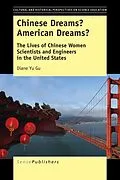Inhalt
Foreword.- Acknowledgments.- List of Tables.- List of Figures.- Prologue.- Section I: The Lived Experiences of Chinese Women Scientists and Engineers.- Introduction: Chinese Dreams, American Dreams.- Historical Overview.- Structure of the Book.- The Women I Studied and My Own Family History.- The Alleged Traitor .- The Chinese Women Scientists and Engineers I Studied.- My Family History.- Intersectionality and the Culture of Science.- The Intersectionality of Gender with Race, Nationality, and Socioeconomic Status.- Perceptions of Science.- Behind the Scenes, Yet Critical Factors.- Gender and Science in a Non-Euro-American Context.- The Experiences of Chinese Women Scientists.- Section II: The Academic Environment and Graduate Studies.- Women in Academia.- Academic Professions and the Importance of Graduate School.- Women in Graduate Science and Engineering Programs.- Glass Ceilings: Barriers to Faculty Careers for Women.- The Influence of Chinese Academia and Culture.- Chinese Women.- Background on Chinese Academia.- History of Women's Participation in Chinese Higher Education.- The Cultural Revolution.- Chinese Graduate Education Since the 1970s.- Age and Gender Discrimination.- Confucian Education Philosophy and Student-Professor Relationships.- Role of Teachers.- Communication in the Classroom.- Social Relations and Holidays.- Disadvantages and Exploitation of Chinese Women Students.- Adulthood and Marriage.- China's Investment in Science and Engineering.- Academic Corruption and Dishonesty.- American Academia: Doctoral Programs.- Historical Overview of American Graduate Schools.- Doctoral Programs in the Twenty-First Century.- Finance and Funding.- Postdoctoral Adventures.- Section III: Chinese Women's Lived Experiences.- Mentoring and Informal Socialization.- Mentoring.- Informal Socialization.- Gendered Mentoring.- Interactions and Communication with Advisers.- Dysfunctional Adviser-Advisee Relationships: Impact of a Lack of Mentoring.- Advisers'and Mentors' Value for Networking.- NSF ADVANCE: Where Are the Foreign-Born Women.- Career Paths.- Common Career Paths.- Discussing Career Expectations with Advisers.- Student Perceptions of Academic Careers.- Career Alternatives.- Challenges and Stereotypes.- Work-Life Balance.- Children.- Dropping out and Mental Health.- Stereotypes of Docile Chinese Women.- Chinese Bias.- Intellectual Property Theft.- Sexual Harassment.- Tacit Knowledge Sharing and Negotiations.- Imposter Syndrome and Peer Networks.- Switching Advisers.- Harmony and Conflict.- Sea Turtles Return to China.- Dual Career Couples.- Chinese Government-Initiated Projects to Attract American-Educated Chinese Scientists and Engineers.- Characteristics of These Initiatives.- Challenges Faced by Haigui.- Sheng Nü (): Leftover Women.- Section IV: Gendered Transnational Networks, Guanxi, and The Power of Reversed Migration.- Guanxi: Cultural and Social Networks among Chinese Women.- The Chinese Diaspora Knowledge Network.- Social Capital and Guanxi.- National Identity and Generational Differences.- Novel Ways of Funding.- Global Scientific Meshworks and Women's Careers.- Meshworks.- Importance of Professional Conferences.- The Benefits of Long-Term Collegiality.- Women Peers and Career Development.- Career Decisions and Connections.- Women's Transnational Networks.- Feminization of Migration.- A Global Network of Women: How Do They Advance Their Careers beyond National Boundaries.- Transnational Network Formation and Globalization of Science and Engineering Knowledge.- Section V: Reflections and Conclusions: Chinese Feminist Perspectives.- Reflections.- Asian Scientists in the U.S..- Disciplinary Differences.- Gendered Communications.- Informal Yet Strong Transnational Ties: Family and Romantic Relationships.- Research and Industry Collaborations.- Marginalization and Tacit Knowledge.- Further Research.- Identity Transformation: Chinese Feminist Perspectives.- Postcolonial Feminism and Women of Color.- Intersectionality and Feminist Theory.- History and Current Discourses of Chinese Feminism.- Globalization and Gender Equality.- The Uniqueness of Chinese Feminism.- Conclusion.- Never the Main Player: The Reality.- Returning to China.- Moving Forward.- Proactive Solutions.- References.
